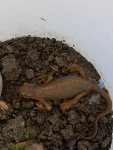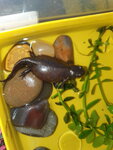redwoodtree
New member
I have a taricha torosa newt that I've been concerned about. He hasn't eaten as much as usual in the last month and appeared to be thin. Previously, he'd been perfectly fine for four years. In the last few days, he moved out of water and appears bloated with spine and ribs clearly showing (photo attached). Does anyone have any advice on how to help him? I've moved him to a separate terrestrial enclosure. He won't eat now, but he has been eating well for the last week or so.


